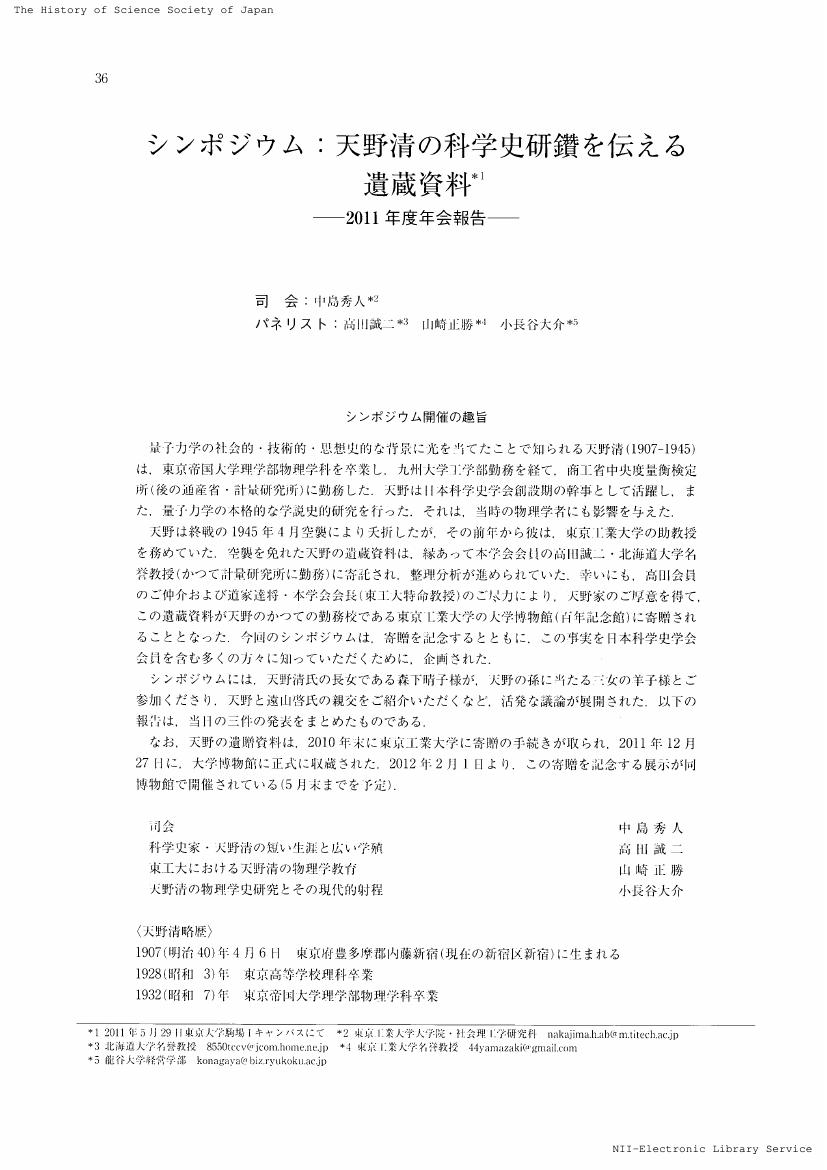10 0 0 0 OA 湯川・朝永・坂田記念史料から分析する日本の素粒子物理学者の系譜
- 著者
- 高岩 義信 九後 太一 早川 尚男 棚橋 誠治 金谷 和至 五島 敏芳 小沼 通二 伊藤 憲二 伊藤 和行 九後 太一 受川 史彦 平田 光司 小長谷 大介 田中 希生 田中 正 難波 忠清 西谷 正 吉川 直志 坂東 昌子
- 出版者
- 筑波技術大学
- 雑誌
- 基盤研究(A)
- 巻号頁・発行日
- 2011-11-18
日本の素粒子論研究が世界的に評価される礎を築いた湯川秀樹・朝永振一郎・坂田昌一の遺した資料を活用してその学問の系譜を研究することを目標とし、その資料の利用環境整備を行った。史料データベースを充実させネットワーク上のサーバーを介して一般に公開している。このサーバで稼働するオープンソフトウェアの検討およびカスタマイズ、さらにその後継ソフトウェアの検討を行った。またこれらの資料を科学史研究に利用するのに有益な史料作成者データのデータベースを、史料カタログと連携するものとして構築することによって、史料の有効利用に資することができるようにすることを検討した。また今後へ向けての課題の検討を行った。
8 0 0 0 OA 三村剛昂と広大理論物理学研究所(歴史の小径)
- 著者
- 小長谷 大介
- 出版者
- 一般社団法人 日本物理学会
- 雑誌
- 日本物理学会誌 (ISSN:00290181)
- 巻号頁・発行日
- vol.68, no.10, pp.685-687, 2013-10-05 (Released:2019-10-17)
4 0 0 0 IR 広大理論研設置をめぐる三村剛昂とその周辺
- 著者
- 小長谷 大介
- 出版者
- 龍谷大学
- 雑誌
- 龍谷紀要 (ISSN:02890917)
- 巻号頁・発行日
- vol.35, no.1, pp.37-45, 2013-09-30
3 0 0 0 歴史の小径 三村剛昂と広大理論物理学研究所
- 著者
- 小長谷 大介
- 出版者
- 一般社団法人日本物理学会
- 雑誌
- 日本物理学会誌 (ISSN:00290181)
- 巻号頁・発行日
- vol.68, no.10, pp.685-687, 2013-10
2 0 0 0 イギリスにおける第二次世界大戦の経験、記憶と「戦後」の形成
日本やドイツなどの第二次世界大戦の敗戦国の「戦後」に関しては、戦争責任や「過去の克服」に関する研究が国内外で進展してきた。一方で戦勝国の「戦後」については、大戦中の戦略爆撃による非戦闘員の大量殺戮、大戦後の統治領域での植民地主義や人種主義の継続など、数々の問題が指摘されているものの十分な研究がなされてこなかった。こうした状況を踏まえ、本研究は戦勝国の中からイギリスに焦点を当て、大戦から受けた複合的、重層的な影響を、外交史、西洋史、文化史、科学史の知見を融合して学際的かつ包括的に検証し、「戦後」をめぐる研究に戦勝国と敗戦国という境界線を越えた形での新たな視座を提示することを目指す。
2 0 0 0 OA F・G・ユンガー技術哲学の現代的意義に関する学際的比較研究
本研究はF・G・ユンガー『技術の完成』(1939年執筆、戦後に公刊)における技術論を哲学、ドイツ文学、エコロジー思想、科学技術史の各観点から総合的に検討することを目指した。同書の論点として、①機械論的自然観と有機的生命観/人間観/社会観との絡み合い、②技術による富/余暇の逆説的な減少過程、ならびに大衆のイデオロギーへの感染性および技術時代の戦争の全面戦争への展開、③富(存在および所有)と時間(生産および余暇)の理論を軸とするエコロジー思想の萌芽を読み取った。ユンガー自身が有するこれら複数の論点を照らし合わせる作業から、科学技術の公共哲学的意義をめぐる議論に新たな一石を投じることができよう。
1 0 0 0 OA シンポジウム:天野清の科学史研鑽を伝える遺蔵資料,2011年度年会報告
1 0 0 0 OA 素粒子論グループの世代間論と湯川記念館設立 : 「ボス」と「若手」の相違と強調
- 著者
- 小長谷 大介
- 出版者
- 日本科学史学会
- 雑誌
- 科学史研究 (ISSN:21887535)
- 巻号頁・発行日
- vol.51, no.261, pp.18-29, 2012 (Released:2021-07-20)
This paper depicts a part of the development of particle physics in Japan after the Second World War. treating the relationship between the establishment of the Yukawa Hall (YH) and the activities of the "Soryushiron Group (SG)." The YH opened as an institute for theoretical physics at Kyoto University in August 1952 in commemoration of Hideki Yukawa's winning of the Nobel Prize in Physics for 1949. The SG was organized mainly as a society of the Japanese young researchers of particle physics in April 1952. Although the previous related studies have argued that the idea of the establishment of YH was deeply connected with the mind of SG. this paper reconsiders how the members of SG worked on the start of YH. who were the main actors of SG in the process of establishing YH, and what these actors did in the formation of YH. Finally it concludes that the different generations of SG represented by "Bosses" and "Young Researchers" played the different roles, preparing the basic constitution of YH. and making the effective systems for promoting and supporting the researches of particle physics.
1 0 0 0 OA 1890年代の熱輻射分布法則導出におけるパッシェンの実験研究の先導的役割
- 著者
- 小長谷 大介
- 出版者
- 日本科学史学会
- 雑誌
- 科学史研究 (ISSN:21887535)
- 巻号頁・発行日
- vol.45, no.240, pp.229-240, 2006 (Released:2021-08-11)
This paper examines the process and development of revolutionary data of thermal radiation in the late 19th century, focusing on Friedrich Paschen's experimental research in the early to mid-1890s. The well-known experiments of O. Lummer and E. Pringsheim, H. Rubens and F. Kurlbaum had brought about the suggestive results concerning Planck's radiation law. Paschen's research played an important role in pioneering experimentalists who were active in the early 1890s. Before Lummer, Pringsheim, Rubens, and Kurlbaum made a series of experiments on the radiation law, Paschen had begun to research on the "Normal Spectrum " representing the spectral distribution of radiation energy. He had made it to examine the spectrum of diffraction grating with the directions of H. Kayser in 1891-1892. In the meantime, other experimentalists such as Lummer and Rubens conducted research on the measurements of luminous intensity and electricity at the request of refining the standards. In 1893 Paschen improved the foundation for experiments on thermal radiation by utilizing those different kinds of measurements and made a step forward in the precision measurements of radiation distribution function.
1 0 0 0 OA 1890年代後半におけるパッシェンの熱輻射研究の再考
- 著者
- 小長谷 大介
- 出版者
- 日本科学史学会
- 雑誌
- 科学史研究 (ISSN:21887535)
- 巻号頁・発行日
- vol.44, no.234, pp.75-85, 2005 (Released:2021-08-12)
Friedrich Paschen (1865-1947) was one of the notable experimental physicists in Germany investigating the spectrum of hydrogen atom, especially spectral series, at the beginning of 20th century. As a part of research related to the spectroscopy, he was engaged with the heat radiation problems in the latter half of the 1890's. However his achievement of this area was not regarded as an important experimental work compared to his spectroscopic researches. This paper reconsiders Paschen's experimental research of radiation in late 1890's. In order to approach that topic, we mainly analyze the setup of radiation sources, the assembly of his bolometer and the range of wavelength of radiation and temperature of radiating bodies in his research. In this paper the features of his experiments are reevaluated in the context of development of radiation experiments during that time. It was certain that Paschen used the source of cavity radiation later than Lummer and Pringsheim and made confirmations of the radiation law in the narrower range of wavelength of radiation than other experimentalists in 1899-1900. However he did work out "numerous experimental confirmations " concerning the radiation law and did give any possible support for the establishment of Planck's radiation law until late 1900.
1 0 0 0 オットー・ハーン : 科学者の義務と責任とは
- 著者
- K.ホフマン著 山崎正勝 小長谷大介 栗原岳史訳
- 出版者
- シュプリンガー・ジャパン
- 巻号頁・発行日
- 2006
1 0 0 0 IR 実験科学者の歴史的評価をめぐる表と裏 : 天野清のパッシェン評を手がかりにして
- 著者
- 小長谷 大介
- 出版者
- 龍谷大学
- 雑誌
- 龍谷紀要 (ISSN:02890917)
- 巻号頁・発行日
- vol.27, no.2, pp.1-16, 2006-01-31
- 被引用文献数
- 1
19-20世紀転換期における科学的諸成果は、当時の社会的状況を背景としながら、理論・実験両者からの地道なアプローチによってもたらされたのである。エネルギー量子発見に絡む熱輻射研究もその例外ではないが、従来の熱輻射研究に関する科学史研究は、「量子論の起原」を探ることを主な目的として理論的文脈に偏る傾向をもっていた。そのためか、熱輻射研究史において、理論的成果と動的に結びつかないように映る実験家の研究内容は、陰の部分に属しがちであった。だが、改めて当時の実験科学的文脈を見直すならば、実験家の仕事の異なる側面が見えてくるのである。ここでは、実験科学者フリードリヒ・パッシェンの熱輻射研究に対して諸評価があるなかで、天野清のパッシェン評を取り上げて、それに対する十分な考察とパッシェン評の再考を行った。その結果、天野によるパッシェン評の3点、空洞による熱輻射の理解不足、ヴィーン法則の「常数」αに関する「不正確な」認識、固体熱輻射源への「重要な材料」の提供というのはいずれも相応な評価と判断できた。また、当時の熱輻射研究の文脈を詳察するならば、さらに異なるパッシェン評を加える必要があった。新たなパッシェン評は、彼が1890年代後半の固体ないし固体-空洞折衷型の熱輻射実験から得た成果についてである。ルンマーらの空洞熱輻射源の実験には長い開発期間が必要だった一方、パッシェンの固体熱輻射源を利用・応用する実験は、当時としては最先端の測定データを短い時間で提供できるものだった。1899年までの熱輻射研究において、パッシェンのデータは大きな存在感をもち、それは当該分野の他の実験家、理論家にとっても重要な価値をもっていた。


